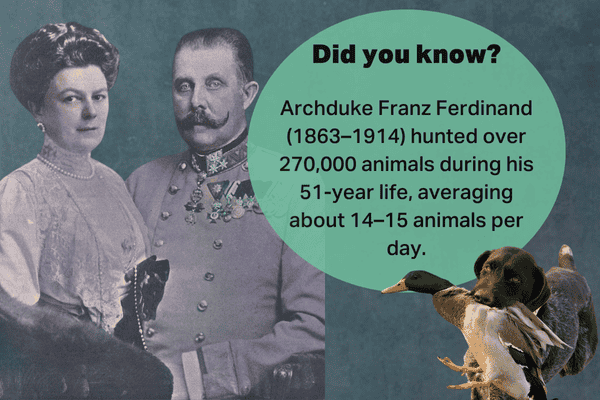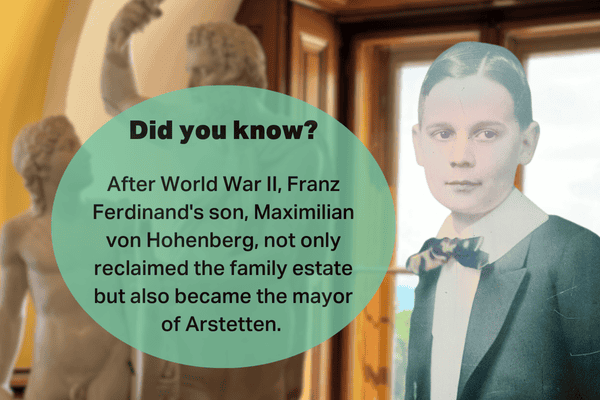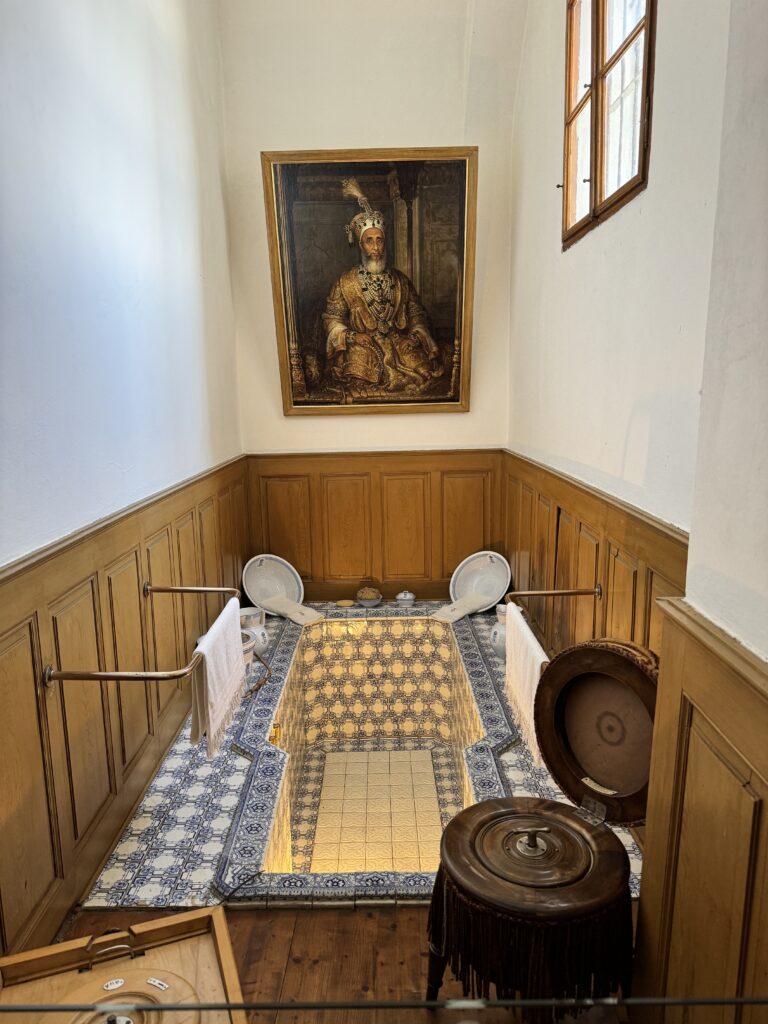Arstetten, a small town nestled along the Danube, holds more than just beautiful views. Its towering castle hides fascinating stories of royalty, untold legends, and mysterious events that shaped history. If you love exploring places rich in history and surprises, Arstetten will capture your imagination. Dive into the secrets of this enchanting town and uncover what makes it truly unforgettable!

Book
Austria by Public Transport
Discover Austria like never before with “Austria by Public Transport.” This book is your ultimate guide to exploring the beauty of Austria easily and affordably. Get your copy today and start your adventure!
Arstetten
Arstetten is a charming small town nestled along the vast Danube River. It lies at the gateway to the Wachau Valley in the beautiful Waldviertel region. A majestic castle towers above the town, visible from afar, reminding visitors of the notable figures who once graced its halls.
In Roman times, the region was part of Noricum. Arstetten is steeped in history; documents first mentioned it in the 13th century. A medieval castle once stood here, expanded many times over the centuries. In the 17th century, it took on its current Renaissance form. The fortress serves as the burial place of Archduke Franz Ferdinand, the former heir to the throne after Emperor Franz Joseph. He and his wife were tragically assassinated in Sarajevo.

Arstetten Good to Know:
- Purchase the Niederösterreich-Card – Get the Lower Austria Card for free entry to Schloss Artstetten and over 300 other attractions.
- Additional Charges – Like guided tours, visiting the garden or special exhibitions, may require extra payment even with the Niederösterreich-Card.
- Visit the Family Crypt – Pay homage at the resting place of the Archduke and his wife Sophie.
Arstetten Castle
The castle still belongs to the Habsburg family, specifically the Hohenbergs. The first structure on the site dates back to the 13th century. They expanded it multiple times, giving it a Renaissance appearance in the 16th century. In 1823, Emperor Franz I added the estate to the Habsburg possessions. He intended it for his wife, so she could reside there after his passing. The property passed through various members of the Habsburg family. In 1889, Archduke Franz Ferdinand inherited it. In 1914, he met his untimely death in Sarajevo.

Franz Ferdinand, the heir to the Austro-Hungarian throne, chose to build a family crypt at Arstetten Castle because of the strict Habsburg family rules. These rules, known as morganatic marriage laws, meant that only royals or members of reigning dynasties could be buried in the prestigious Capuchin Crypt in Vienna. Franz Ferdinand’s wife, Sophie, Duchess of Hohenberg, came from a noble family but did not belong to a reigning dynasty.

Because of her lower status, she could not be buried alongside Habsburg rulers. To ensure they could rest together, Franz Ferdinand had a private crypt built for his family at Arstetten, where he, Sophie, and their children could be laid to rest.

Arstetten in XX Century
After Franz Ferdinand’s assassination, his son Maximilian von Hohenberg inherited Arstetten Castle. However, following the end of World War I, the Habsburgs, including the Hohenbergs, lost most of their property due to new laws aimed at dismantling the aristocracy’s wealth. Despite this, the Hohenbergs managed to keep Arstetten Castle for a time.
In 1938, when Nazi Germany annexed Austria, the Hohenberg family was targeted by the Nazis due to their royal ties. Maximilian and his brother Ernst were imprisoned in the Dachau concentration camp, and the family lost control of the castle.

After World War II, the Hohenbergs were able to reclaim Arstetten thanks to the Allied restitution process, which returned properties seized by the Nazis. Their status as victims of Nazi persecution helped them recover their family estate. Since then, the castle has remained in the Hohenberg family, and in 1982, they opened the Franz Ferdinand Museum to honor their legacy and the Archduke’s history.
Warnings Before the Tragedy:
- Franz Ferdinand had a feeling something bad would happen before his trip to Sarajevo. He even told his servants what to do if he died.
- The Serbian government knew about the plan to kill him. They told people in Vienna, but no one listened to the warning.
- In Sarajevo, someone threw a grenade at his car. The grenade bounced off and exploded in the crowd, killing people. Franz wanted to go back to Vienna to stay safe, but an official told him to stay for lunch, and he did.
The Legend
of the White Chamois
The legend of the white chamois is one of the most fascinating myths linked to Habsburg hunting traditions. It connects to the tragic fates of two important figures—Archduke Rudolf and Archduke Franz Ferdinand.

Kordian
Hey, it’s me, Kordian! I spend like 10 to 20 hours on each post just for you. This website is my main source of income. If you enjoy using it regularly, I’d totally appreciate your financial support. Your help means a lot and keeps the content coming. Thanks a bunch!
For centuries, white animals held symbolic meanings in various cultures. In Europe, especially in Slavic and Balkan mythology, people considered the white chamois a magical creature. They believed that killing a white animal, especially a chamois, would bring misfortune or violent death within a year. Such legends circulated in Southeastern Europe, where the white chamois, known as the “Golden Horn,” symbolized miraculous power.
The story begins with Archduke Rudolf, son of Emperor Franz Joseph. In 1878, during a hunt near Potsdam, Rudolf shot a white ten-point deer. According to legend, this act started the misfortunes that befell him. Eleven years later, in 1889, Rudolf died under mysterious circumstances at Mayerling Castle.
A similar tale involves Archduke Franz Ferdinand. In 1913, during a chamois hunt south of Salzburg, he killed a white chamois. The animal was an albino, which strengthened the belief in its supernatural significance. Less than a year after this event, on June 28, 1914, Gavrilo Princip assassinated Franz Ferdinand and his wife Sophie in Sarajevo. This assassination directly led to the outbreak of World War I.
The legend of the white chamois, though rooted in mythology and superstition, gained special importance in the Habsburg family’s history. Some residents near Salzburg, where Franz Ferdinand killed the white chamois, still believe that if not for that fateful shot, history might have unfolded differently. Perhaps the archduke would have avoided the assassination, and World War I might not have erupted so soon.

Subscribe
Explore Vienna like a local and discover nearby treasures.
Join our mailing list!
Arstetten Today
Arstetten invites visitors to explore its rich tapestry of history and legend. The town’s picturesque setting along the Danube River offers a serene backdrop for reflection and discovery. The castle stands as a testament to the notable figures and events that shaped not only the region but also the world. Walking through its halls, you can almost hear whispers of imperial intrigues and age-old legends.
The Franz Ferdinand Museum provides an intimate glimpse into the life of the archduke and his family. Personal artifacts, photographs, and historical documents bring their story to life. The family crypt, still in use today, adds a profound sense of continuity and reverence.
Gallery




Visit Arstetten
Arstetten and its majestic castle offer a unique window into a bygone era where history and myth intertwine. Therefore, if you ever find yourself wandering through the Waldviertel region, make sure to visit this enchanting place. Ultimately, standing on the castle grounds, overlooking the vast Danube, you might just feel connected to the legends and legacies that continue to shape our understanding of the past.
Join Our Vibrant Community
Are you passionate about discovering the hidden gems of Vienna and its surroundings? Follow us on social media and become part of our enthusiastic community!
Why Follow Us?
- Exclusive Content: Each post is a labor of love, taking between 10-30 hours to create. We share breathtaking photos, captivating stories, and invaluable tips.
- Stay Updated: Never miss out on exciting events, new attractions, and must-visit spots in and around Vienna.
- Support Independent Projects: We are an independent project, and your follows help us cover the costs of running this page. Your support is crucial!
Your Support Matters!
Every follow, like, and share directly supports our work. It helps us continue bringing you the best content and ensures we can keep this site running. By following us, you’re not just staying informed – you’re helping us grow and thrive.
Don’t miss out! Click the links above and start following us today. We can’t wait to connect with you!





